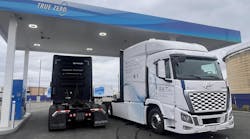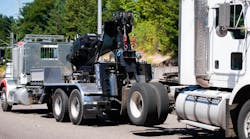Imagine a truck that would automatically send messages to other vehicles in the area about an icy bridge deck, a dangerous curve or an obstacle in the roadway or even notify the local highway department about a pothole that urgently needs filling. A new test program launched this summer in Michigan may help to bring this capability closer to reality and help the transportation industry take the next steps to improve safety and reduce highway congestion.
The Road Commission for Oakland County, MI (RCOC), the Michigan Dept. of Transportation (MDOT) and Illinois-based Motorola have teamed up to test a new communications technology aimed at supporting the Federal Highway Administration’s Vehicle Infrastructure Integration (VII) initiative. VII is a transportation technology initiative intended to enable vehicles to communicate directly with the road infrastructure, as well as with other vehicles.
The Michigan test involves the installation of transmission equipment on RCOC traffic signal poles in the area around RCOC’s Traffic Operations Center in Waterford Township, as well as in several test vehicles. According to RCOC, it the first-ever use of Motorola’s “MotoDrive” wireless network architecture operating over the 5.9 GHz radio frequency. “Two or three years ago, the Federal Communications Commission (FCC) allocated the 5.9 GHz radio frequency for connecting vehicles to the highway infrastructure and to each other,” says RCOC spokesperson Craig Bryson. “It was a visionary move really, but until now the technology has not been available to take full advantage of it.”
MotoDrive leverages Motorola’s Mesh Enabled Architecture networks and assembles other components and technologies to create a mesh network designed to quickly, securely and reliably send large amounts of data wirelessly from transmitter devices mounted alongside the roadway. The network can even receive and send data from vehicles in the area that are equipped with the necessary onboard technology. The whole process is called Dedicated Short-Range Communications (DCSR) and the hope is that it will help to make highways safer by gathering certain data from various onboard vehicle sensors and sharing it immediately with those who need to know.
“Amazingly enough, lots of the required sensors are already in vehicles today,” says Bryson. “The challenge now is to find a way to capture the data from those sensors, filter out the irrelevant information and share the important data with those who need to know it. For example, suppose that the network picks up signals from braking systems on vehicles in the area showing hard braking at a certain point along the roadway. Drivers approaching that point could get a warning to slow down while MDOT could get a message via the internet about a hazardous pothole that has to be filled. Or, if the ambient temperature is below freezing and the network ‘sees’ windshield wipers coming on, it could mean freezing rain. We think the safety potential is enormous.”
Privacy is an issue with VII, notes Bryson, and so keeping the data anonymous has been considered critical right from the beginning. “Vehicle manufacturers have been adamant about keeping the data aggregated and anonymous,” he says. “This is not about monitoring the speed of individual drivers, for instance, and remotely issuing tickets.”
Motorola is paying the hard costs for the Michigan test, according to Bryson, while RCOC and MDOT are making the required staff and infrastructure resources available. The test is expected to be completed this fall, although Bryson notes that, “we’ll run it until we are satisfied we have learned all that we can learn.”
More information is available at www.rcocweb.org and at www.motorola.com
To comment on this article, write to Wendy Leavitt at [email protected]



